| Company Portrait | Quality System | Organigram |
| Board of Directors | Memberships |
Contact |
| Management | History |
Maps |
Design of metro lines and tunnels



Location:BUDAPEST
Principal:BUDAPEST Municipality 1052 Budapest, Városház u. 9-11 CONSULTANT
Year:
Revenue:
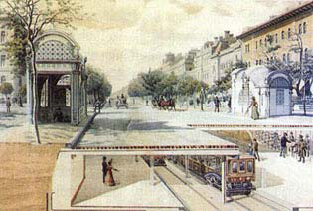
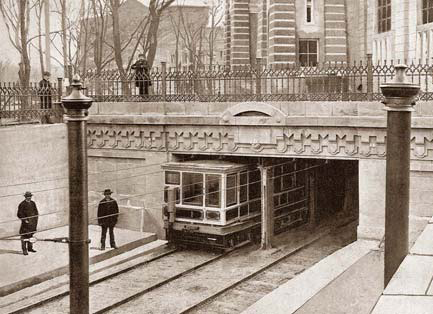
Period picture on the underground railway The original tunnel front in Városliget
History of the line M1
The line M1 of the Budapest metro network - known in the Budapest idiomatic language as "Millennium underground railway" - was put into operation, as the first underground railway of the continent, on May 2nd 1896, at the millennial of the entry of the Hungarians in the Carpathian Basin. The 3,7 km long facility with 9 underground and 2 surface stations was constructed by Siemens-Halske in two years. At the time of opening the facility represented a technical level far ahead of its time. The traffic was ensured by pivoted carriages, the power supply from its own current-generating plant, driven by steam-engine. The signaling equipment of the railway operated safely until 1973. The trains operated with a headway of 2 minutes, the number of daily travels reached ~34.500. The line connected the downtown with Városliget (Town Park), following the straight alignment of the modern boulevard Andrássy út, opened for the public in 1876. The outskirts terminus of the line was situated in the popular amusement quarter of the inhabitants of Budapest, beside the Zoo and the Széchenyi bath.
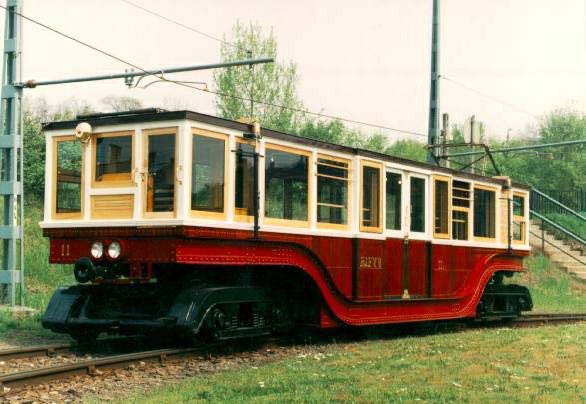
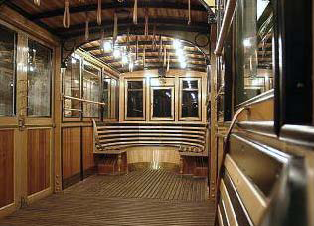
The original motor-coach Interior of the original train
Extension of the line M1, and realignement
The residential areas of Budapest, beyond Városliget, were largely extended in the 1960ies –1970ies. This trend rendered necessary the lengthening of the line M1, a project which was realized in 1973.
The extended section of 1,5 km runs under the surface on its entire length, and two new stations were constructed. In totality the number of stations did not change, because two stations were abolished on the short surface section. As a result, every station of the 4,4 km long line is now situated under the ground surface.
In parallel with the construction of the first section of the metro line M2, the downtown section alignment of the line M1 had to be modified, in the zone of the intersection of the three metro lines. The aim of realizing this realignment was to ensure the possibility of comfortable and quick transfer from the line M1 to the two other lines. Due to the realignment of the line the original station at Deák tér was demolished, and a new station was constructed with the same name. On the short line section, which was terminated, an underground railway museum was realized.
The general designer of the line extension and realignment was UVATERV Engineering Consultants.
Reconstruction of the line M1
In 1996 the line M1 celebrated its centenary. During its operation free from significant traffic troubles the structures and the related technical equipment became age-worn, making the reconstruction urgent. The reconstruction program initiated by the Municipality of Budapest and with the participation of the EBRD was started in 1993 and encompassed the following
areas:
- Reconstruction of the permanent way using a reinforced concrete bedding with flexible fastening, welded rails adhered to the sleepers
- Reinforcing the roof of the tunnel and stations, provision of waterproofing, laying new asphalt pavement
- Overhauling the architectural, interior architectural and mechanical systems of stations
- Modernizing the electrical systems the passenger safety and railway signaling systems, installing new safety features
List of the works realized by the general designer UVATERV Engineering Consultants:
- Geodesic survey
- Designing the permanent way
- Designing the architecture and interior architecture of stations
- Modernizing the electrical systems
- Designing the passenger safety and signaling system of railway operation
Geodetic survey
The track reconstruction had its precondition the geodesic survey of the entire line, including the investigation of the clearance as well. This latter was necessary because of the fact that the new track was to allow a speed of 60 km/h in the extremely narrow spaces.
Reconstruction of the track
The new track was constructed with joint-free welded rails of 48,5 kg/m, laid on reinforced concrete bed, in glued finish, with an anchorage distance of 750 mm.
The gauge is 1435 mm, the inclination of the rails is 1:20, compared to the horizontal level.
The reinforced concrete bed – with steel bar mandrels and coating aimed at improving the capacity of adhesion - is solidly connected to the original, well conserved concrete structure of the tunnel. The 30 mm thick polyurethane plate installed at the rail fastenings resulted in a considerable mitigation of noise and vibration.
Reconstruction of the stations
Out of the 11 stations of the line M1, 8 stations are original, and 3 stations are newly constructed. All the 11 stations needed to be reconstructed.
The original ancient stations were reconstructed in a way keeping their period image and atmosphere of the late 19th century. The 3 new stations reflect the architectural aspects of our modern age.
After completing an architectural survey, UVATERV Rt. prepared the reconstruction design on the basis of the original drawings still available. The stations of historical significance were designed with features corresponding to the original design, including the original claddings and general appearance. The heads of columns, the cover units of the corners, as
well as the windows were established according to the original patterns. The separating railings along the central row of pillars, as well as the cable supports were also designed to show a historically true appearance. The swinging doors, ticket offices on the platform and the doors hiding the modern technology at the end of the platform also required a very thorough work. It was a special challenge to design the reconstruction of the handrails and parapets of the access staircase, where the passengers had to be protected from splashing mud. The selection of the lamp fixtures for the historical stations was also an exciting job with the objective to match the modern technology to the mode of the station. The night security of the stations is facilitated with gratings, which can be operated manually or automatically. The original Millennium Underground Railway was extended in 1973 in a style then considered to be modern. The image of these stations were also retained in our design, however, more advanced and durable materials were applied. The materials and the structures were also handled with a unified concept also for the new stations. The monotonous appearance of stations was eliminated by the use of various colors and with the application of different ornamental features.
Modernization of the electrical and safety systems
- During the reconstruction of the 600 V DC traction power supply the entire system was provided with new, stat-of-the-art protection, and also the fire protection of the cables was resolved.
- A fire- and smoke detection system was installed on the whole length of the line.
- The telecommunication system, which was completely renovated, allows the central control of the train and passenger traffic, by traffic and a passenger traffic dispatcher. The following technical equipment is available:
• Passenger information
- Public announce system of stations
- Visual passenger information system
- Clock and timer network
• Safety equipment
- Emergency request system
- Video system
- Remote switching and control system
- Traction voltage indication
- Telecommunication cabinets
• Fire alarm system
• Central ticket selling and ticket validation system
• Radio telephone network
• Digital data transmission system
• Central dispatcher equipment
• Railway signaling equipment
The modernization included the power supply to telecommunication and the fire protection of cables as well.
The data transmission is carried out through optic cables, on the entire length of the line.
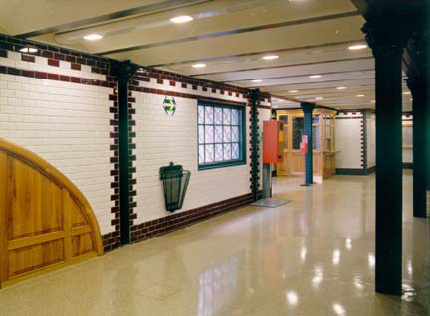
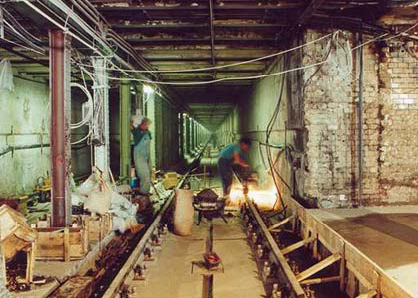
Period-authentic design, modern lighting The new track is under construction
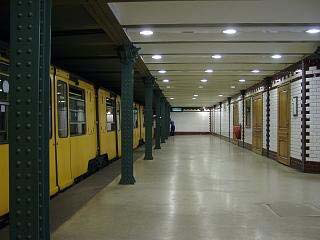
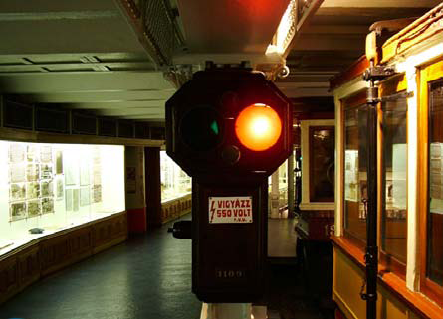
The reconstructed downtown terminus In the “Underground railway” museum
Date of design: 1994
Date of implementation: 1995